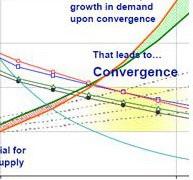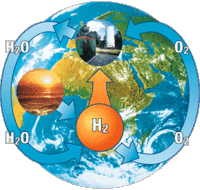Think of this as Volume 18, Number 31 of the newsletter I have written weekly since March, 1997. Enjoy.

That is its solution. I've been writing about it for over five years now.
The solution is renewable energy.
Think about it. What's fueling the present conflict between Israel and Hamas? Oil money, from Qatar and the other Gulf states, without which Hamas would collapse. As would ISIS in Syria and Iraq. What fuels the Boko Haram in Nigeria? Oil money, or the hope of obtaining it. What makes Putin feel invulnerable in Ukraine? Oil money.
Yet think about this. Texas now gets over 10% of its grid energy from wind. New Jersey gets the same amount from solar. Efficiency and the drive to kick oil is driving all sorts of innovations, from Tesla cars to LED light bulbs. Efficiency pays for itself in energy savings. The amount of grid energy needed by the U.S. has barely changed in a half-decade, thanks to efficiency. The amount of gasoline consumed has also stayed about the same, thanks to efficiency.
Every day, still, there are new breakthroughs happening, in terms of energy storage, in solar panel efficiency and cost, in windmill efficiency and cost, in biomass catalysts. It's all approaching a tipping point.
And that tipping point is closer than it appears.

Don't believe it can happen? It already has. Have you priced coal assets lately? A natural gas pipeline in North Dakota has problems getting funded because natural gas prices are so low. Nearly a third is being flared because there's no infrastructure and no market for infrastructure to get it to market.
Now that's primarily a U.S. problem, and a temporary one. The world price for natural gas is three times what Americans pay. The opening of export terminals will raise the U.S. price, creating a market for new infrastructure, slowly ending the flaring.
Why hasn't this happened with oil, which costs more than natural gas? Because oil is fungible. You can move it and store it. There's a cost, but that cost is lowest when it goes by ship, rising as it goes via pipeline, train and truck. North Dakota producers are getting far less for their product than Texas producers for this reason – a shortage of infrastructure. But it's still profitable. For now.
What happens when it isn't? It goes away, the way coal is going away. How far are we from that point? Closer than we realize.

That's also happening right now. Why do you think utilities are trying to charge homeowners a monthly fee if they put solar panels on their homes?
Of course, there's another weapon that the oil barons have against renewable energy. That is the ability to take a price cut. That's what took down the Soviet Union in the 1980s – the price of oil and then gold fell, and the government couldn't pay to match Reagan's military buildup.
But this time it's different. That's because fracking costs a lot of money. Sure, Saudi Arabia may pay just $4/barrel to bring oil out of the ground, but in the Bakken they pay a lot more, something closer to $50/barrel – which doesn't include the infrastructure needed to get it to market. Profit margins on new American oil are pretty small.

That crossover point represents a huge geopolitical opportunity. That crossover point will drive U.S. economic policy toward renewables, meaning it will drive investment dollars toward renewables and drive our diplomatic policy toward renewables. The U.S. will start to lead the world in renewables when it's in our economic interest to do so.
Despite all our sins, and they have been many, the U.S. remains the world's greatest hope, for liberty, for capitalism, and for erasing the lines. What do you think happens when we no longer get any benefit from allowing people to jump over lines, which happens automatically when we really move toward a renewable economy? Policy will change.

Economics have been moving slowly toward a renewable future for years. The policy of the Obama Administration, its support for renewables, has accelerated a trend that was already in motion. Crossover is coming. We've seen it in coal already, we'll see it in oil before too many years have passed.
The opportunity will then exist to start erasing lines, and putting everyone under the rule of law. The answer to the question of global warming and the answer to the problem of line jumping are the same.










